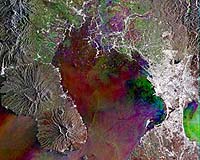 |
Sydney (UPI) Mar 3, 2009 Natural gas is forecast to account for more than one-third of Australia's electricity generation by 2030, an industry report stated. In launching the Australian Energy Resource Assessment Monday, Australian Minister for Resources and Energy Martin Ferguson referred to it as "a national prospectus for energy investment and exports." Compiled by the Australian Bureau of Agricultural and Resource Economics and Geoscience Australia, the 344-page report examines factors likely to affect the country's energy resources through 2030. "The two big findings are the extraordinary potential of coal seam methane and unconventional gas resources and, for the first time, we can see just how extensive Australia's renewable energy resources are," Ferguson said in a release. The report shows Australia's total identified coal seam gas resources are more than 42 trillion cubic feet, not counting the "even larger" estimated potential for in-ground resources. The report states that, Australia's primary energy consumption will increase by 1.4 percent each year to reach about 214,306-gigawatt hours by 2029-30, from 2007-08 levels of 160,333-gigawatt hours, The Sydney Morning Herald reports. Australia's primary energy mix is project to change "significantly," the report shows, with coal's share expected to fall to 23 percent and the share of natural gas to rise to 33 percent. Wind energy is predicted to increase by 2 percent. Ferguson noted that Australia needs a more flexible, decentralized grid capacity for renewable energy. Ferguson said the assessment shows Australia's coal and gas resources "can support energy demand for many decades to come." But the report shows that Australia's resources of crude oil are more limited. Without significant new discoveries of crude oil or development of condensate resources, it says, the country's dependence on oil is likely to increase. As for exports, Australia's net energy trade is expected to increase by 3.9 percent each year through 2030, with exports of liquefied natural gas to rise significantly, the report said. In 2008, Australia exported 744 billion cubic feet of LNG, according to the U.S. Energy Information Administration with LNG exports increasing by 48 percent over the last decade. "If we get the settings right, Australia can not only secure its own energy future but become the premier supplier of energy resources in the Asia Pacific region," Ferguson said. The Australian Petroleum Production & Exploration Association's Chief Executive Belinda Robinson said the AERA report represents a "bright future" for the industry. There are now more than $200 billion worth of projects on the drawing board with the potential to create up to 55,000 new jobs in the country in the next 10-15 years, she said in a statement.
Share This Article With Planet Earth
Related Links
 Blackouts in Philippine capital
Blackouts in Philippine capitalManila (AFP) March 1, 2010 Parts of the Philippine capital suffered blackouts on Monday, officials said, as a drought-induced power crisis deepened across the impoverished Southeast Asian nation. The Manila Electric Company, which serves the city's 12 million residents, said it was forced to implement two-hour rotating power outages across the capital and neighbouring provinces to help address an energy shortfall. ... read more |
|
| The content herein, unless otherwise known to be public domain, are Copyright 1995-2010 - SpaceDaily. AFP and UPI Wire Stories are copyright Agence France-Presse and United Press International. ESA Portal Reports are copyright European Space Agency. All NASA sourced material is public domain. Additional copyrights may apply in whole or part to other bona fide parties. Advertising does not imply endorsement,agreement or approval of any opinions, statements or information provided by SpaceDaily on any Web page published or hosted by SpaceDaily. Privacy Statement |